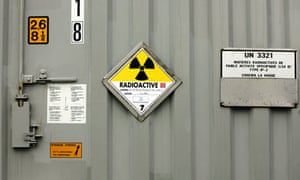Don't believe the spin on thorium being a greener nuclear option
In a world increasingly aware of and affected by global warming, the news that 2010 was a record year for greenhouse gases levels was something of a blow.
With the world's population due to hit nine billion by 2050, it highlights the increasingly urgent need to find a clean, reliable and renewable source of energy.
India hopes it has the answer: thorium, a naturally occurring radioactive element, four times more abundant than uranium in the earth's crust.
The pro-thorium lobby claim a single tonne of thorium burned in a molten salt reactor (MSR) – typically a liquid fluoride thorium reactor (LFTR) – which has liquid rather than solid fuel, can produce one gigawatt of energy. A traditional pressurised water reactor (PWR) would need to burn 250 tonnes of uranium to produce the same amount of energy.
They also produce less waste, have no weapons-grade by-products, can consume legacy plutonium stockpiles and are meltdown-proof – if the hype is to be believed.
India certainly has faith, with a burgeoning population, chronic electricity shortage, few friends on the global nuclear stage (it hasn't signed the nuclear non-proliferation treaty) and the world's largest reserves of thorium. 'Green' nuclear could help defuse opposition at home (the approval of two new traditional nuclear power reactors on its west coast led to fierce protests recently) and allow it to push ahead unhindered with its stated aim of generating 270GW of energy from nuclear by 2050.
China, Russia, France and the US are also pursuing the technology, while India's department of atomic energy and the UK's Engineering and Physical Sciences Research Council are jointly funding five UK research programmes into it.
There is a significant sticking point to the promotion of thorium as the 'great green hope' of clean energy production: it remains unproven on a commercial scale. While it has been around since the 1950s (and an experimental 10MW LFTR did run for five years during the 1960s at Oak Ridge National Laboratory in the US, though using uranium and plutonium as fuel) it is still a next generation nuclear technology – theoretical.
China did announce this year that it intended to develop a thorium MSR, but nuclear radiologist Peter Karamoskos, of the International Campaign to Abolish Nuclear Weapons (ICAN), says the world shouldn't hold its breath.
'Without exception, [thorium reactors] have never been commercially viable, nor do any of the intended new designs even remotely seem to be viable. Like all nuclear power production they rely on extensive taxpayer subsidies; the only difference is that with thorium and other breeder reactors these are of an order of magnitude greater, which is why no government has ever continued their funding.'
China's development will persist until it experiences the ongoing major technical hurdles the rest of the nuclear club have discovered, he says.
Others see thorium as a smokescreen to perpetuate the status quo: the world's only operating thorium reactor – India's Kakrapar-1 – is actually a converted PWR, for example. 'This could be seen to excuse the continued use of PWRs until thorium is [widely] available,' points out Peter Rowberry of No Money for Nuclear (NM4N) and Communities Against Nuclear Expansion (CANE).
In his reading, thorium is merely a way of deflecting attention and criticism from the dangers of the uranium fuel cycle and excusing the pumping of more money into the industry.
And yet the nuclear industry itself is also sceptical, with none of the big players backing what should be – in PR terms and in a post-Fukushima world – its radioactive holy grail: safe reactors producing more energy for less and cheaper fuel.
In fact, a 2010 National Nuclear Laboratory (NNL) report (PDF)concluded the thorium fuel cycle 'does not currently have a role to play in the UK context [and] is likely to have only a limited role internationally for some years ahead' – in short, it concluded, the claims for thorium were 'overstated'.
Proponents counter that the NNL paper fails to address the question of MSR technology, evidence of its bias towards an industry wedded to PWRs. Reliant on diverse uranium/plutonium revenue streams – fuel packages and fuel reprocessing, for example – the nuclear energy giants will never give thorium a fair hearing, they say.
But even were its commercial viability established, given 2010's soaring greenhouse gas levels, thorium is one magic bullet that is years off target. Those who support renewables say they will have come so far in cost and efficiency terms by the time the technology is perfected and upscaled that thorium reactors will already be uneconomic. Indeed, if renewables had a fraction of nuclear's current subsidies they could already be light years ahead.
All other issues aside, thorium is still nuclear energy, say environmentalists, its reactors disgorging the same toxic byproducts and fissile waste with the same millennial half-lives. Oliver Tickell, author of Kyoto2, says the fission materials produced from thorium are of a different spectrum to those from uranium-235, but 'include many dangerous-to-health alpha and beta emitters'.
Tickell says thorium reactors would not reduce the volume of waste from uranium reactors. 'It will create a whole new volume of radioactive waste from previously radio-inert thorium, on top of the waste from uranium reactors. Looked at in these terms, it's a way of multiplying the volume of radioactive waste humanity can create several times over.'
Putative waste benefits – such as the impressive claims made by former Nasa scientist Kirk Sorensen, one of thorium's staunchest advocates – have the potential to be outweighed by a proliferating number of MSRs. There are already 442 traditional reactors already in operation globally, according to the International Atomic Energy Agency. The by-products of thousands of smaller, ostensibly less wasteful reactors would soon add up.
Anti-nuclear campaigner Peter Karamoskos goes further, dismissing a 'dishonest fantasy' perpetuated by the pro-nuclear lobby.
Thorium cannot in itself power a reactor; unlike natural uranium, it does not contain enough fissile material to initiate a nuclear chain reaction. As a result it must first be bombarded with neutrons to produce the highly radioactive isotope uranium-233 – 'so these are really U-233 reactors,' says Karamoskos.
This isotope is more hazardous than the U-235 used in conventional reactors, he adds, because it produces U-232 as a side effect (half life: 160,000 years), on top of familiar fission by-products such as technetium-99 (half life: up to 300,000 years) and iodine-129 (half life: 15.7 million years).Add in actinides such as protactinium-231 (half life: 33,000 years) and it soon becomes apparent that thorium's superficial cleanliness will still depend on digging some pretty deep holes to bury the highly radioactive waste.
With billions of pounds already spent on nuclear research, reactor construction and decommissioning costs – dwarfing commitments to renewables – and proposed reform of the UK electricity markets apparently hiding subsidies to the nuclear industry, the thorium dream is considered by many to be a dangerous diversion.
Energy consultant and former Friends of the Earth anti-nuclear campaigner Neil Crumpton says the government would be better deferring all decisions about its new nuclear building plans and fuel reprocessing until the early 2020s: 'By that time much more will be known about Generation IV technologies including LFTRs and their waste-consuming capability.'
In the meantime, says Jean McSorley, senior consultant for Greenpeace's nuclear campaign, the pressing issue is to reduce energy demand and implement a major renewables programme in the UK and internationally – after all, even conventional nuclear reactors will not deliver what the world needs in terms of safe, affordable electricity, let alone a whole raft of new ones.
'Even if thorium technology does progress to the point where it might be commercially viable, it will face the same problems as conventional nuclear: it is not renewable or sustainable and cannot effectively connect to smart grids. The technology is not tried and tested, and none of the main players is interested. Thorium reactors are no more than a distraction.'





No comments:
Post a Comment